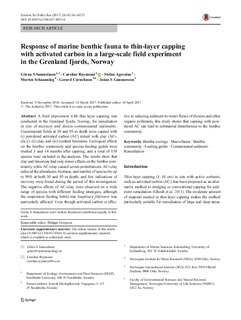| dc.contributor.author | Samuelsson, Göran S. | |
| dc.contributor.author | Raymond, Caroline | |
| dc.contributor.author | Agrenius, Stefan | |
| dc.contributor.author | Schaanning, Morten | |
| dc.contributor.author | Cornelissen, Gerard | |
| dc.contributor.author | Gunnarsson, Jonas S. | |
| dc.date.accessioned | 2018-03-20T13:46:57Z | |
| dc.date.available | 2018-03-20T13:46:57Z | |
| dc.date.created | 2017-06-22T10:26:07Z | |
| dc.date.issued | 2017 | |
| dc.identifier.citation | Environmental science and pollution research international. 2017, 24 (16), 14218-14233. | nb_NO |
| dc.identifier.issn | 0944-1344 | |
| dc.identifier.uri | http://hdl.handle.net/11250/2491300 | |
| dc.description.abstract | A field experiment with thin-layer capping was conducted in the Grenland fjords, Norway, for remediation in situ of mercury and dioxin-contaminated sediments. Experimental fields at 30 and 95 m depth were capped with (i) powdered activated carbon (AC) mixed with clay (AC+cla`y), (ii) clay, and (iii) crushed limestone. Ecological effects on the benthic community and species-feeding guilds were studied 1 and 14 months after capping, and a total of 158 species were included in the analyses. The results show that clay and limestone had only minor effects on the benthic community, while AC+clay caused severe perturbations. AC+clay reduced the abundance, biomass, and number of species by up to 90% at both 30 and 95 m depth, and few indications of recovery were found during the period of this investigation. The negative effects of AC+clay were observed on a wide range of species with different feeding strategies, although the suspension feeding brittle star Amphiura filiformis was particularly affected. Even though activated carbon is effective in reducing sediment-to-water fluxes of dioxins and other organic pollutants, this study shows that capping with powdered AC can lead to substantial disturbances to the benthic community. | nb_NO |
| dc.language.iso | eng | nb_NO |
| dc.publisher | Springer Verlag | nb_NO |
| dc.rights | Navngivelse 4.0 Internasjonal | * |
| dc.rights.uri | http://creativecommons.org/licenses/by/4.0/deed.no | * |
| dc.title | Response of marine benthic fauna to thin-layer capping with activated carbon in a large-scale field experiment in the Grenland fjords, Norway | nb_NO |
| dc.type | Journal article | nb_NO |
| dc.type | Peer reviewed | nb_NO |
| dc.description.version | publishedVersion | nb_NO |
| dc.source.pagenumber | 14218-14233 | nb_NO |
| dc.source.volume | 24 | nb_NO |
| dc.source.journal | Environmental science and pollution research international | nb_NO |
| dc.source.issue | 16 | nb_NO |
| dc.identifier.doi | 10.1007/s11356-017-8851-6 | |
| dc.identifier.cristin | 1478108 | |
| dc.relation.project | Norges forskningsråd: 182720 | nb_NO |
| dc.relation.project | Vetenskapsrådet: 210-2007-282 | nb_NO |
| cristin.unitcode | 7464,20,12,0 | |
| cristin.unitname | Marin forurensning | |
| cristin.ispublished | true | |
| cristin.fulltext | original | |
| cristin.qualitycode | 1 | |

